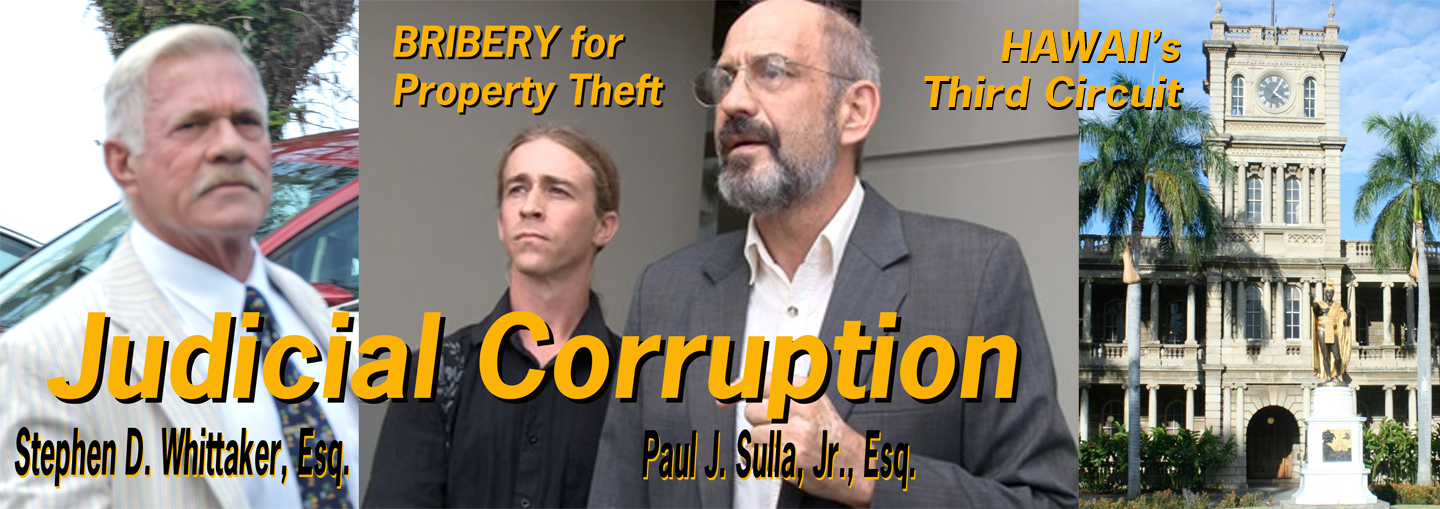Corruption in Our Courts: What It Looks Like and Where It Is Hidden
Foreword by
Dr. Leonard G. Horowitz
This article provides a scholarly legal review of the horrible problem of bribery tainting America’s justice system. I became aware of this problem in my own case against attorney Paul J. Sulla, Jr., ongoing in the Third Circuit Court of Hawaii at the time of this writing (2-1-16).
Briefly in my saga, I caused attorney Sulla to be disqualified by Federal Court judges in the case of Hester v. Horowitz–a “Quiet Title” action wherein Mr. Sulla manufactured the Plaintiff, a shill named Jason Hester (shown in the banner above). Sulla manufactured Hester to conceal the lawyer’s own conflicting interests in my property.
I knew Mr. Hester to be a penniless drifter and drug dealer. Sulla used Hester as a “front-man” to commit a fraudulent trust and money laundering scheme to steal my property. Sulla directed Hester to co-conduct an illegal non-judicial foreclosure in 2010. To do this Sulla manufactured a fake “church,” put Hester supposedly in charge of this illegal trust, then exclusively swore by affidavit to the legitimacy of “Hester’s foreclosure.” Sulla’s affidavit of “Mortgagee’s Foreclosure” was steeped in fraud as evidenced by forgeries and false assignments of my mortgage and note. But the Third Circuit Court of Hawaii judges, Elizabeth A. Strance and Ronald Ibarra, turned willfully-blind eyes to my (and my attorney’s) filed evidence in order to aid-and-abet Sulla’s crimes. Bribery is strongly suspected in this matter, but is grossly apparent with attorney Stephen D. Whittaker in this case.
Once attorney Sulla was disqualified in Federal Court in this matter, Hester was compelled by the federal judges to secure alternative counsel (since Sulla was adjudged to be a “necessary witness at trial.”) Sulla, of course, objected, claiming Hester would suffer financial hardship due to his poverty. Yet, within one week, attorney Stephen D. Whittaker entered to replace Sulla. Whittaker immediately commenced filing Sulla’s pleadings knowing very well that Sulla was the concealed real party in interest. In essence, it is obvious that Sulla, who is widely known to be a drug trafficking “King Pin” operating on the Big Island of Hawaii, bribed Whittaker to advance my ejectment and Sulla’s property theft.
Mine is a classic case of judicial bribery, since not only were the corrupt judges aware that Hester could not afford costly counsel, especially two expensive lawyers–Sulla and Whittaker–but Judge Elizabeth Strance, and later her replacement, Ronald Ibarra, also knew Sulla had filed and litigated the case illegally as the concealed real party in interest, using forged, illegally manufactured, and altered documents.
The following scholarly article by Stratos Pahis is an excellent review of the legal literature providing everything you need to know about this scourge of official malfeasance rampant in America today.
Stratos Pahis
118 Yale L.J. 1900 (2009).
Recent surveys and events indicate that judicial corruption could be a significant problem in the United States. This Note builds an economic model of bribery to better understand the incentives behind this pernicious phenomenon. It then compiles a data set of discovered incidents of judicial bribery in the United States to test the effectiveness of our anti-judicial-corruption institutions. This analysis suggests that our institutions are particularly ineffective at preventing and uncovering judicial bribery in civil disputes and traffic hearings.
Click here to read the entire publication.









RSS